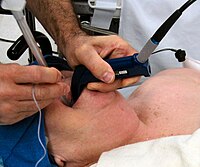
Photo from wikipedia
Abstract Introduction: Airway management is a controversial topic in modern Emergency Medical Services (EMS) systems. Among many concerns regarding endotracheal intubation (ETI), unrecognized esophageal intubation and observations of unfavorable neurologic… Click to show full abstract
Abstract Introduction: Airway management is a controversial topic in modern Emergency Medical Services (EMS) systems. Among many concerns regarding endotracheal intubation (ETI), unrecognized esophageal intubation and observations of unfavorable neurologic outcomes in some studies raise the question of whether alternative airway techniques should be first-line in EMS airway management protocols. Supraglottic airway devices (SADs) are simpler to use, provide reliable oxygenation and ventilation, and may thus be an alternative first-line airway device for paramedics. In 2019, Alachua County Fire Rescue (ACFR; Alachua, Florida USA) introduced a novel protocol for advanced airway management emphasizing first-line use of a second-generation SAD (i-gel) for patients requiring medication-facilitated airway management (referred to as “rapid sequence airway” [RSA] protocol). Study Objective: This was a one-year quality assurance review of care provided under the RSA protocol looking at compliance and first-pass success rate of first-line SAD use. Methods: Records were obtained from the agency’s electronic medical record (EMR), searching for the use of the RSA protocol, advanced airway devices, or either ketamine or rocuronium. If available, hospital follow-up data regarding patient condition and emergency department (ED) airway exchange were obtained. Results: During the first year, 33 advanced airway attempts were made under the protocol by 23 paramedics. Overall, compliance with the airway device sequence as specified in the protocol was 72.7%. When ETI was non-compliantly used as first-line airway device, the first-pass success rate was 44.4% compared to 87.5% with adherence to first-line SAD use. All prehospital SADs were exchanged in the ED in a delayed fashion and almost exclusively per physician preference alone. In no case was the SAD exchanged for suspected dislodgement evidenced by lack of capnography. Conclusion: First-line use of a SAD was associated with a high first-pass attempt success rate in a real-life cohort of prehospital advanced airway encounters. No SAD required emergent exchange upon hospital arrival.
Journal Title: Prehospital and Disaster Medicine
Year Published: 2022
Link to full text (if available)
Share on Social Media: Sign Up to like & get
recommendations!